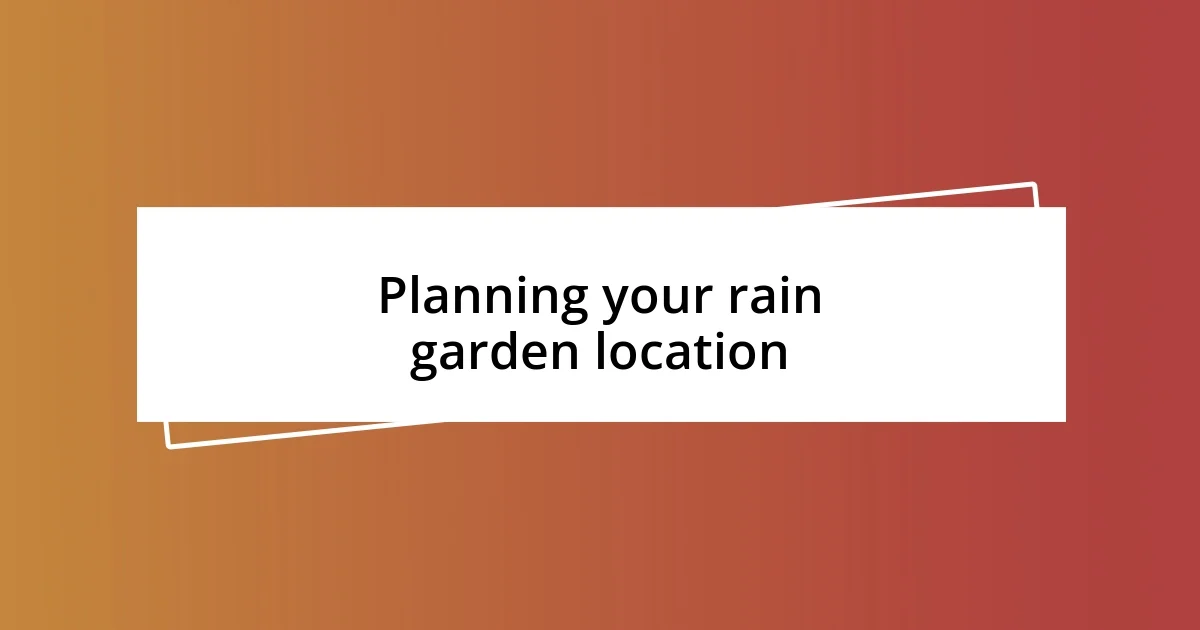Key takeaways:
- Rain gardens effectively manage stormwater runoff, improve local ecosystems, and filter pollutants from rainwater, enhancing both beauty and functionality in landscapes.
- Proper planning for a rain garden includes assessing water flow, ensuring adequate sun exposure, and positioning near downspouts to maximize efficiency.
- Successful installation involves preparing the soil with organic matter, creating a suitable layout with varying depths, and implementing drainage solutions like perforated pipes.

Understanding rain gardens
Rain gardens are an innovative solution to manage stormwater runoff, improving both aesthetics and functionality in our landscapes. I remember the first time I saw a rain garden—it was like an oasis in my neighborhood, drawing in butterflies and birds while effectively soaking up the rain. Seeing nature flourish in such a purposeful way made me wonder, shouldn’t every yard have one?
At their core, rain gardens are shallow depressions planted with native plants that can absorb excess rainfall. When I installed my own, I was amazed by how the landscape transformed, creating a vibrant ecosystem right in my backyard. It felt rewarding to contribute to the environment and witness firsthand how something so simple could combat flooding and erosion. Have you ever considered how a small change in your garden could have such a significant impact?
What’s truly wonderful about rain gardens is their ability to filter pollutants from rainwater before it reaches our waterways. In my experience, watching the raindrops dance into the garden and disappear into the soil brought a sense of accomplishment. It prompted me to think about the tiny actions we can all take to protect our local environment, one rain garden at a time. Isn’t it inspiring to think that small acts can generate such positive ripple effects?

Planning your rain garden location
When planning your rain garden location, I find that it’s crucial to assess the water flow patterns in your yard. Observing how rainwater flows—whether it collects in certain spots or runs away—can guide you to the best placement for your garden. I recall one particular rainstorm when I noticed a steady stream of water pooling in my yard. It wasn’t just a nuisance; it highlighted the idea that I could redirect this water into a purposeful space.
Another important consideration is sun exposure. Native plants thrive in sunlight, so choosing a location that receives at least six hours of sun daily is ideal. In my own experience, I initially picked a spot with some shade, thinking it would offer protection to the plants. However, after realizing how much their growth slowed, I quickly shifted my garden to a sunnier area—and the transformation was incredible. It’s amazing how the right amount of sunlight can make a world of difference.
Finally, proximity to downspouts or paved areas is essential. I learned that placing my rain garden near a downspout helped maximize its efficiency in managing runoff. If you’re located near hard surfaces like sidewalks or driveways, consider positioning the garden so it can catch and filter runoff effectively. After all, the goal is to create a garden that not only works with the landscape but also enhances it beautifully.
| Location Consideration | My Experience |
|---|---|
| Water Flow Patterns | Identified pooling areas during a rainstorm, leading to an optimal garden spot. |
| Sun Exposure | Moved my garden to a sunnier location after slow plant growth in shade. |
| Proximity to Downspouts | Placing the garden near downspouts maximized its ability to manage runoff. |

Choosing the right plants
Choosing the right plants for your rain garden is vital to its success. I learned that native plants are the best choice because they are already adapted to your area’s climate and soil conditions, making them hardy and easier to maintain. In my case, selecting plants that could handle both wet and dry spells turned out to be a game-changer. Watching my plants thrive through heavy rain and then bloom beautifully in drier months filled me with a sense of pride and connection to nature.
Here are some principles I considered when choosing plants:
- Native Species: I discovered that local plants attract beneficial wildlife, like pollinators and birds. Their resilience is a big plus.
- Diversity: I mixed different types (grasses, flowers, and shrubs) to create a more dynamic ecosystem. Seeing how they interact has been surprisingly satisfying.
- Water Tolerance: I focused on plants that can withstand both wet conditions and occasional droughts. This adaptability ensures the garden remains vibrant.
- Growth Habit: I took care to choose plants with varying heights and structures. This layering effect not only looks beautiful but also helps with water absorption.
- Seasonal Interest: I was mindful of plants that bloom at different times throughout the year, ensuring that my rain garden looks lively regardless of the season.
Selecting plants for my rain garden felt like curating a collection of nature’s best. It was not just about form and function for me; it was about creating a little piece of harmony in my yard that would be a joy to watch grow and evolve over time.

Designing the rain garden layout
Designing the layout of your rain garden is an exciting yet calculated venture. From my experience, it’s crucial to carefully consider the shape and size. I often found that a more irregular, curved design mimicked nature beautifully, allowing water to flow in more naturally. The first time I sketched mine out with sweeping curves instead of straight lines, I felt a wave of creativity wash over me, as if I was creating a living artwork.
Another vital aspect is the depth of the garden bed. I learned through trial and error that digging deeper in certain areas creates pockets for water to gather. This not only helps with water absorption but also adds a variety of habitats for beneficial organisms. I remember when I first watched tadpoles thrive in those small water pockets—it felt like I was nurturing a tiny ecosystem right in my yard!
As you finalize your layout, consider adding a small berm on the uphill side. This slight elevation helps to divert water into your garden. I was pleasantly surprised by how much more effective my rain garden became after incorporating this feature. It’s the little details like this that can truly transform a simple garden into a thriving, vibrant space. Have you thought about the little details that might enhance your rain garden layout?

Preparing the soil for planting
Preparing the soil for planting is one of the most crucial steps I experienced while building my rain garden. I remember the first time I got my hands dirty, gently turning over the earth and feeling the soil’s texture. I found that loosening the ground really helps create an inviting environment for the roots of my plants. It’s all about ensuring the soil can absorb water and drain properly.
Next, I made sure to mix in organic matter, like compost. This not only enriched the soil but also improved its ability to retain moisture. I still recall the joy of watching earthworms wriggle through the soil as I worked—an encouraging sign that I was fostering a healthy ecosystem. Have you ever paused to think how life teems beneath the surface, all working to support your garden’s growth?
Finally, I tested the pH of my soil. I wanted to ensure it was suitable for my chosen plants. During this process, I discovered that most native plants thrive in slightly acidic to neutral soil. I remember being pleasantly surprised at how easy it was to adjust the pH with a bit of lime or sulfur, depending on what my soil needed. It felt empowering to know I could create the best possible conditions for my plants to flourish. Are you ready to dig in and create the perfect soil foundation for your rain garden, too?

Installing the rain garden
Installing the rain garden was truly a hands-on experience for me. Armed with a shovel and my plans, I set to work on the prepared site, feeling a rush of energy with each scoop of soil I removed. I found it surprisingly satisfying to watch the space transform, imagining all the rainwater pooling into the garden as I went. Have you ever felt that thrill of creating something with your own hands?
Next came the installation of a perforated pipe at the bottom of the garden bed. This pipe helps manage drainage, guiding excess water away when needed. I recall the moment I laid it down, thinking about how this simple addition could make a world of difference. Seeing it all come together, I felt a connection to the ecosystem I was nurturing. Isn’t it fascinating how every detail, no matter how small, plays a role?
Once the structure was in place, I added layers of mulch to retain moisture and prevent weeds. I remember spreading the mulch and noticing how it not only looked beautiful but also created a cozy environment for my plants. As I stood back to admire the completed installation, I felt a strong sense of accomplishment. When you take the time to invest in such a project, don’t you find it rewarding to see your vision come to life?














